Children on the brink of starvation
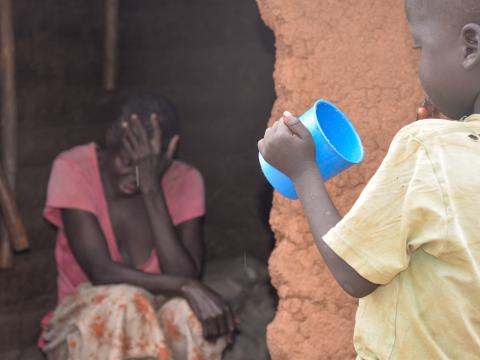
By Aggrey Nyondwa Kikobera - Communications Official, World Vision in Uganda
Seven-year-old Evelyn and her family haven’t eaten anything in nearly 24 hours. Hunger has stripped them of all energy and even smiles. Evelyn’s little brothers sit near the kitchen door, eyes fixed on the cold cooking place and the surrounding empty saucepans.
Their mother, 23-year-old Annet Rojo, is seated, legs stretched on the veranda, trying to breastfeed her wailing baby. Their father, 25-year-old James Moro, lost in thought, leans despondently against a huge water tank at the corner of the house. You can easily tell that he is thinking about where the day’s meal for his family is going to come from.
There is no life in this home. Children are not playing. No one is smiling and there is barely a word said for about a quarter of an hour. The only sound is the constant sobbing of Annet’s baby, every time he realises that the breast he is suckling yields nothing.
A few minutes later, an exhausted 60-year-old Magdalena Kujang, Evelyn’s grandmother, arrives, a bundle of firewood skilfully resting on her head. She had been gone for over six hours.
“I went as early as [8am]. Sometimes I just want to be away from here because if I stay, the children will keep asking for what to eat”, she says.
Magdalena might have found the firewood, but there is nothing at home to cook.
"It is just by faith that I go to fetch firewood, even when I know there is no food to cook with it", she says.
The family of 10 last ate yesterday, having shared a mere kilogramme of cassava (four cups) that Annet borrowed from the neighbours who also have barely any food for themselves.
“We now mostly depend on the neighbours to survive. We borrow food and beg for food sometimes. Sometimes they give it to us but sometimes they don’t”, she says.
If they fail to get any food, Annet says they are forced to uproot the young beans they grow in the compound to make sauce –just sauce, without food. But in worse situations, the family has gone hungry for days.
“You cannot depend on neighbours the whole time. About a week ago, we spent four days without eating”, she says.
Despite the hunger, Evelyn, being the eldest at home, is expected to help with chores. Today, she is helping to wash utensils; cups and plates with traces of dry porridge from yesterday’s meal.
“I am hungry, I just want to eat”, she says with a faint voice.
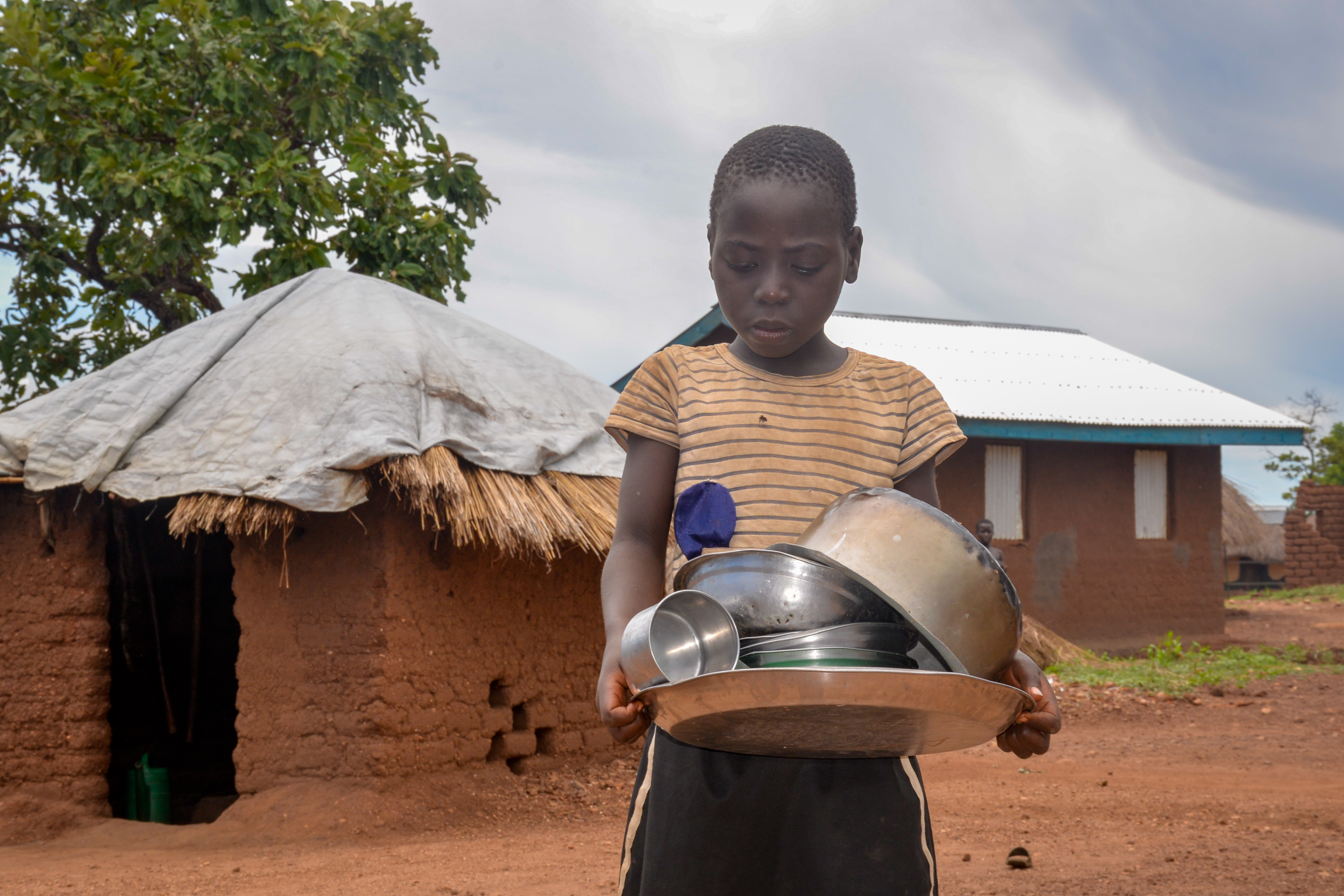
Evelyn’s father, who used to dig to earn an income, says labour opportunities are now hard to get. Before the COVID-19 pandemic, there was demand for farm and off-farm labour, which would earn him up to UGX 10,000 a day (US$3), enough to buy food for a few days.
“It is sad to see that as a man I cannot provide for my family. The situation wasn’t this bad before. The food was enough and people would sell part of it to get money to pay us for the work we would do. But now, everyone is poor and hungry”, James says.
Pastor Isaac to the rescue
As Evelyn’s mother desperately looks at the setting sun, she is worried another day is going to pass without her children eating food. Earlier in the day, the children’s grandmother managed to get them some porridge from the flour she borrowed from a neighbour, but after a few hours, the children were hungry again. If they sleep without eating food, they will cry the whole night.
However, joy returns to Annet and Magdalena’s faces when Pastor Isaac Badai, their neighbour and leader of the local church, hands them UGX 5,000 (US$1.5) to buy food and avoid sleeping hungry.
“People in this village think that because I am a pastor, God has blessed me with a lot of extra food and money, which is not the case. I also struggle sometimes but this doesn’t stop me from helping my people whenever I can”, says Isaac, who is also a refugee from South Sudan.
Isaac notes that the situation is getting out of hand and the community has resorted to survival mechanisms like reduced meal portions, borrowing and begging. Others are returning to war-torn South Sudan.
“So many people come to me asking for what to eat. I mostly help those that are in much need, like the elderly and widows who fail to feed their children. Many people now eat once a day, while others go for days without food”, he says.
“If you move around this village, you will find a lot of abandoned houses. These belong to people who have run back to South Sudan to look for food. This is very dangerous because our country is not safe yet. They end up getting killed as soon as they arrive there and others are killed while still on the road”, Isaac says.
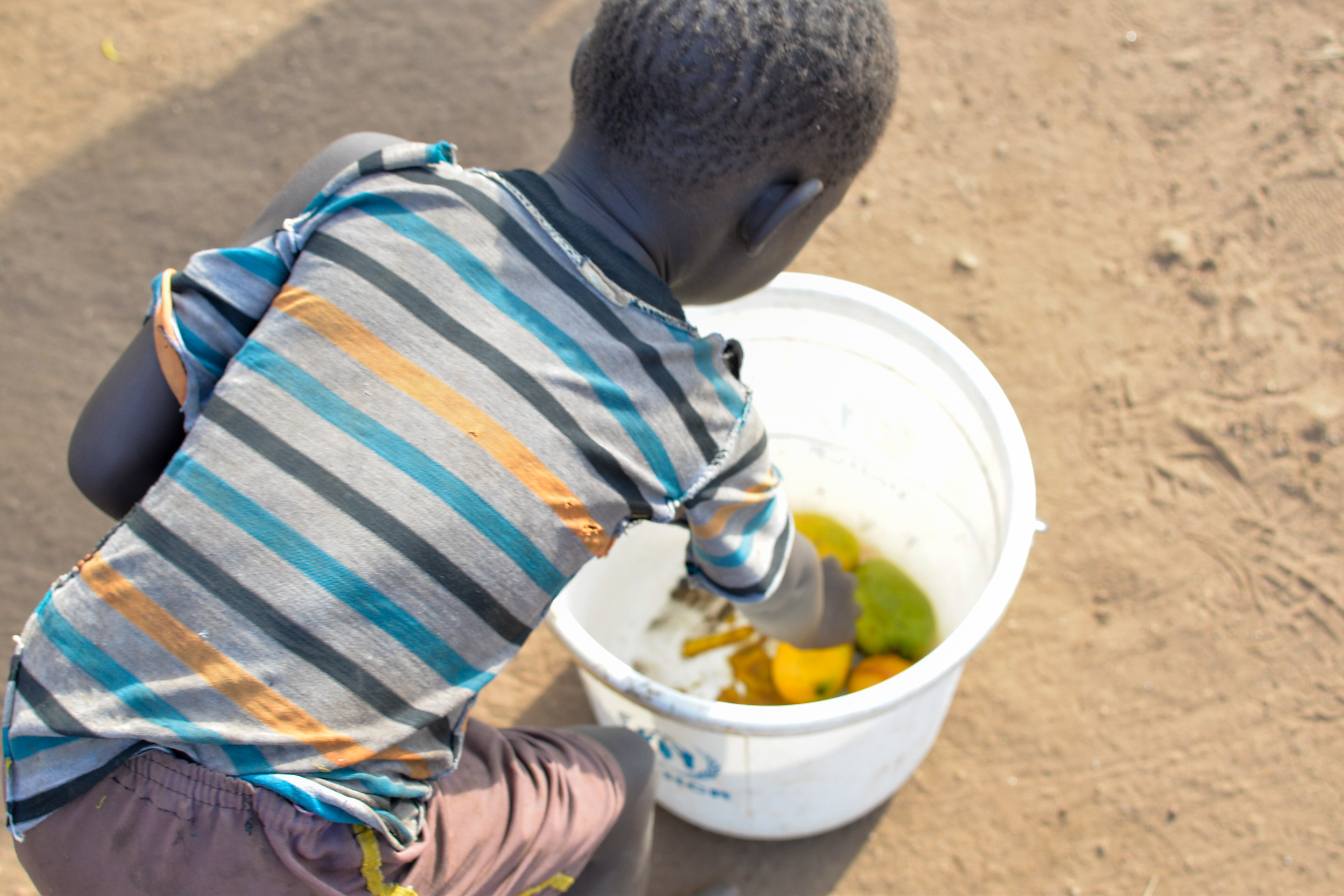
According to FEWS NET, a famine early warning system, households in rural refugee settlements are expected to face a hunger crisis (Integrated Food Security Phase Classification [IPC]3) between February and May and August and November, due to limited access to income-generating activities, inadequate crop production and low coping capacity.
Sharing the little meal
After securing a little food, Magdalena joyfully makes dinner for her grandchildren. She only prepares part of the food, as preparing it all would mean they go hungry again tomorrow. This means, not everyone will eat tonight. As Evelyn and her siblings enjoy the small meal at dusk, their grandparents and mother look on.
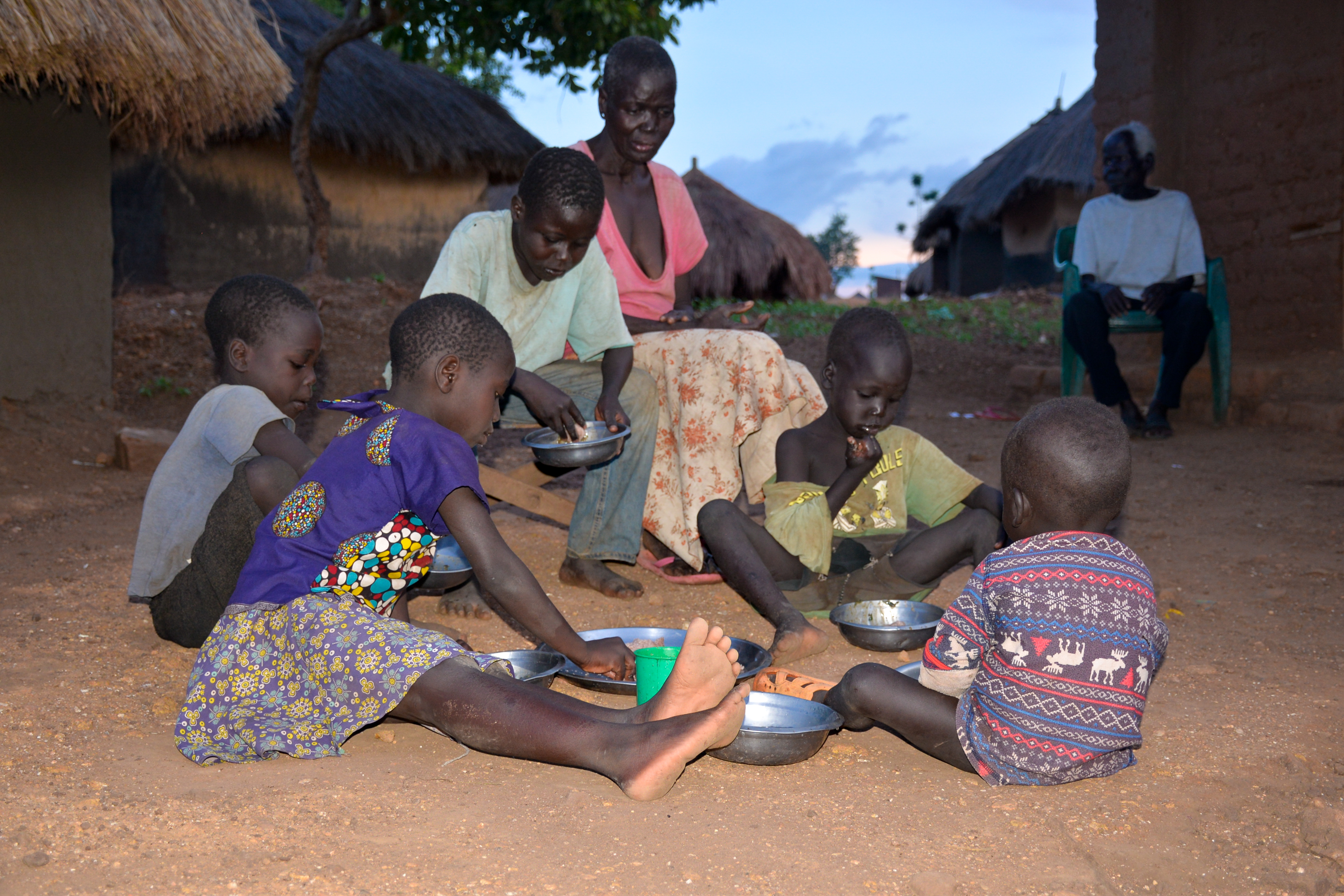
“We had porridge during the day, so, we can hold on to that throughout the night, but the children cannot. That’s why we have let them enjoy the food because we need to keep some for tomorrow’s porridge at lunch”, explains Magdalena.
In the blink of an eye, the food disappears from the big plate. The children lick their lips and peep into saucepans to see if there is more.
Ration cuts: The genesis of the problem
Refugees have always had challenges with the amount of food they receive, but last year’s 30% ration cut, amidst a pandemic, was the last nail in the coffin. With a continued decline in funding, leading to a $96 million shortfall, the World Food Programme (WFP) announced further cuts in February 2021. Currently, refugees have to make do with only 60% of a full ration.
“The hunger crisis is widespread, but particularly dangerous for the refugee community who are already battling the effects of COVID-19. Most of them lost their small businesses and all income-generating activities, so, a reduced ration cut could only mean worse”, says Paul Mwirichia, the Cash and Food Assistance Manager at World Vision in Uganda.
Indeed, according to a recent food assessment survey by WFP, the current 40% ration cut and the impact of COVID-19 lockdowns are major contributors to hunger in the refugee settlements. The Integrated Food Security Phase Classification (IPC) analysis (June-December 2020) found that refugees in Uganda’s 13 settlements faced acute food insecurity.
Refugee leaders are now appealing to donors and the international community for support.
“We understand that most of the people who support us were also affected by the pandemic, but we appeal to them not to get tired of helping refugees; God will reward them”, says Pastor Isaac.
As a measure to avert the spread of COVID-19, food distributions are now planned to take place once in two months. This means that refugees get a double ration which they have to keep for two months. This is difficult because in most cases the food meant to last two months is usually consumed by the fifth or sixth week, leaving children and their families staring hunger right in the eye.
“The food gets done so fast and we have to wait almost an entire month before the next distribution”, says Elizabeth Nial, a teenager looking after seven siblings and a child of her own. “When the food is finished, I move around the village borrowing from neighbours. Some give us the food in kind, while others loan it to us, and we pay it back when the rations come.”
World Vision is helping families to overcome hunger
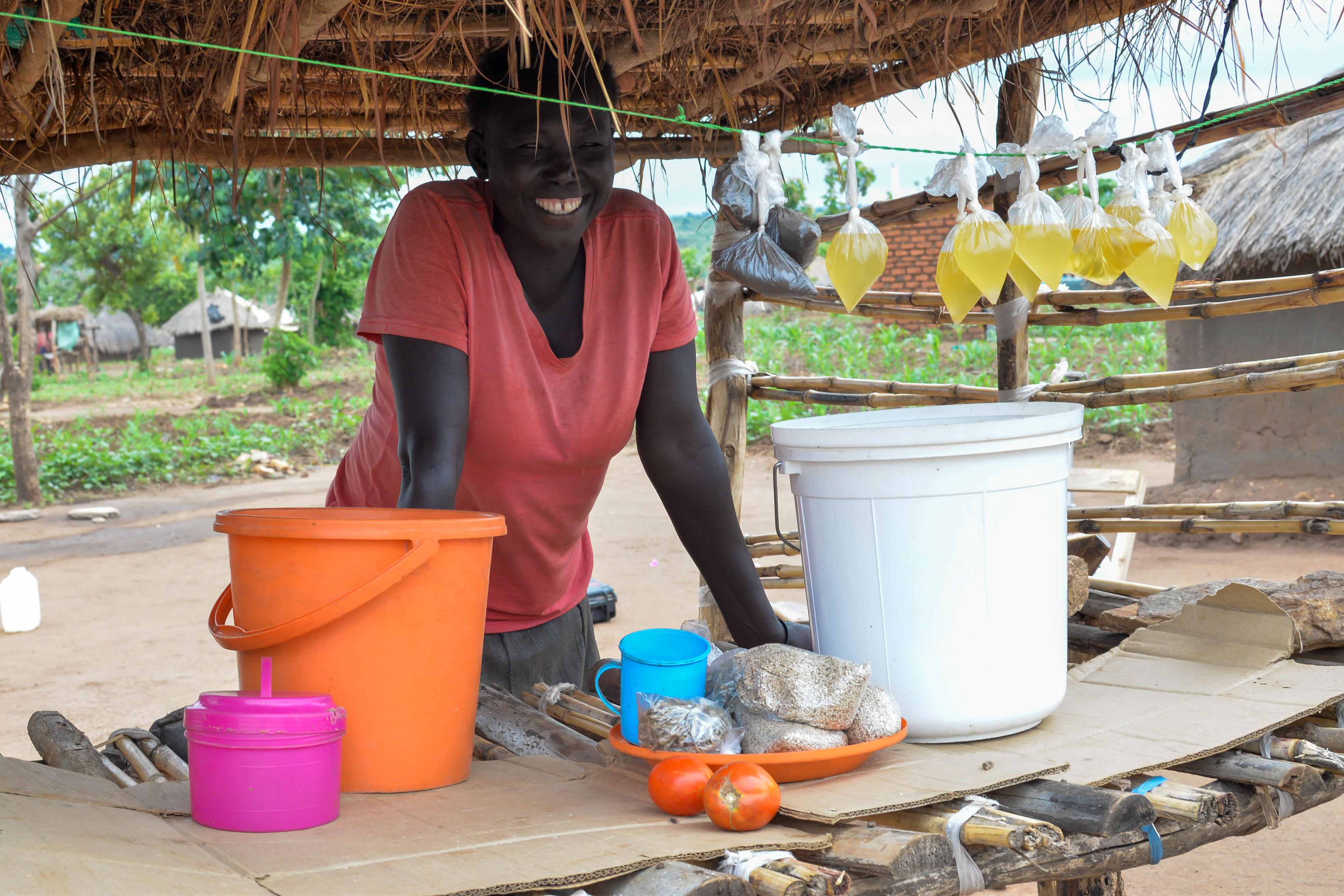
Unlike many others in the settlement, 37-year-old Agness Jagoro is a very happy woman. She eats three meals a day and she can afford an alternative diet for her children. Agnes also runs a small business at her home that earns her UGX 20,000 (US$5) a day –enough to buy extra food for her family. Agnes is a member of a savings group called “God Knows”, supported by World Vision. The group has also received a loan from VisionFund to help them inject more money into their businesses.
“Joining this savings group has raised my family’s standard of living. I can afford whatever I want, including clothes and good diet. The last time we shared the money, I got UGX 500,000 (US$140) which I used to buy furniture and scholastic materials for the children”, says the mother of seven. World Vision is helping refugees like Agnes plug the gap by supporting them with income-generating projects such as farming, savings for transformation, and skills development.
“The situation is bad, but some refugees, with our help, are making the most of the support we provide and we have seen some change and rise in resilience levels”, says Paul.
More than 370,000 people in Uganda are a step closer to famine. These are mainly in the Karamoja region and the refugee communities which are under IPC 4 and 3 respectively, with a total of more than 195,000 children suffering from acute malnutrition. FEWS NET warns that between June and September, with the expected continued ration cuts, despite it being a harvesting season, at least 20% of refugees will continue to experience food consumption gaps, with the situation expected to get worse in August and September.